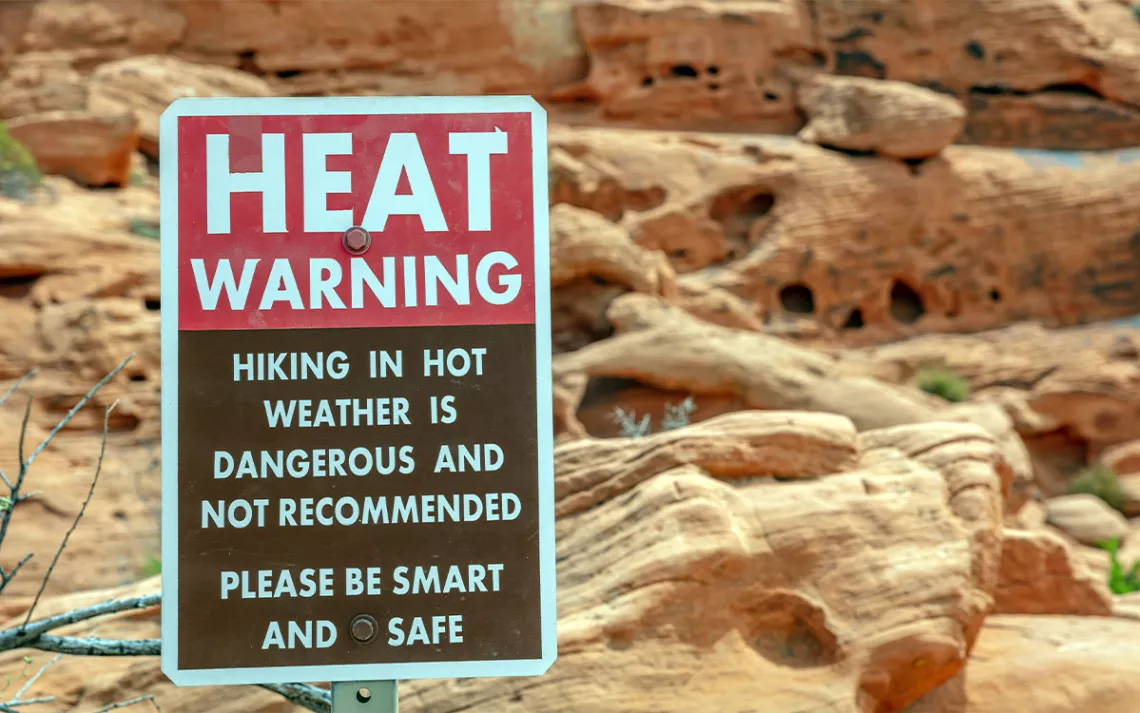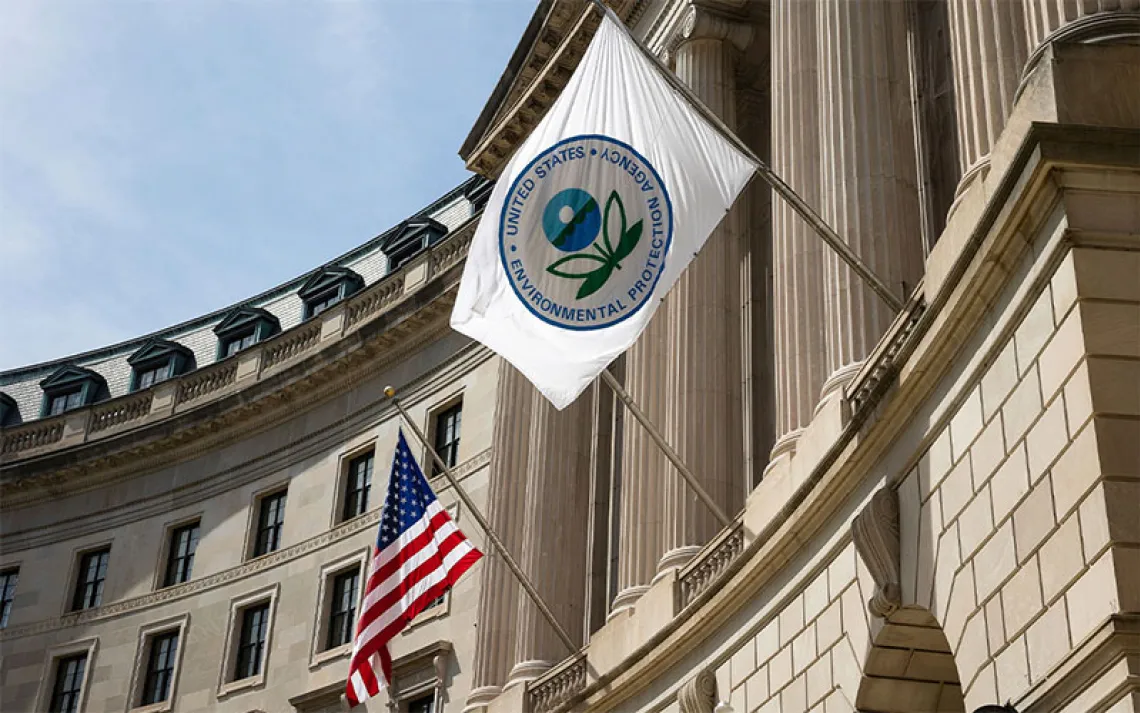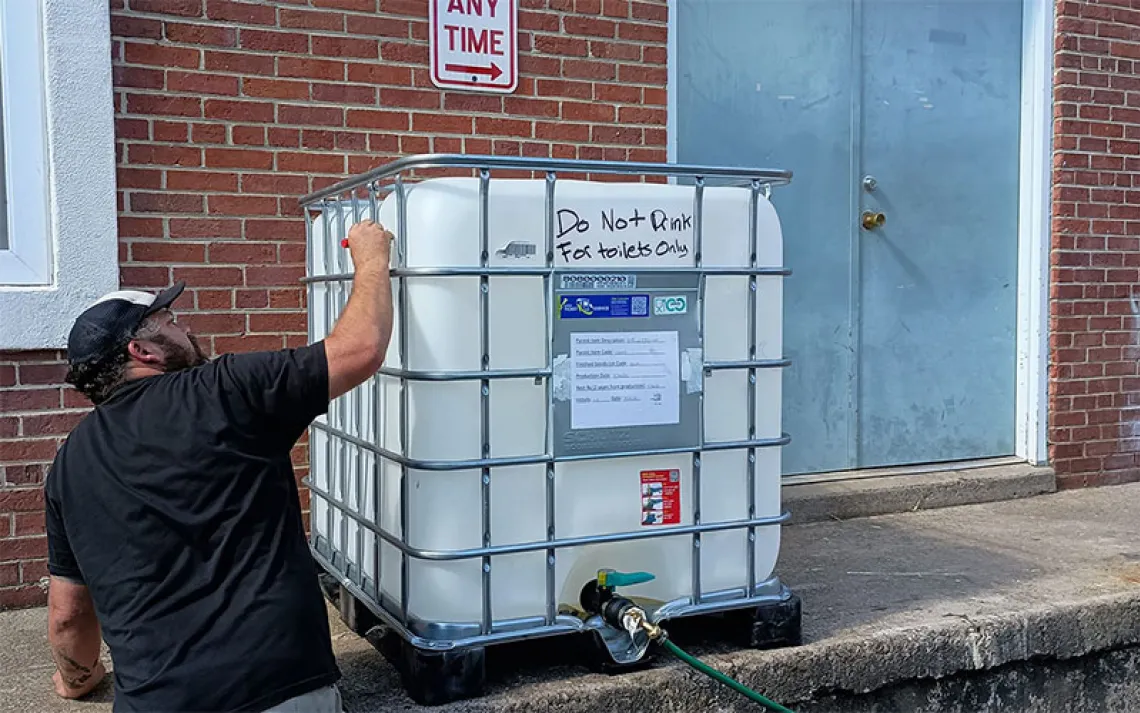Climate-Change-Intensified Summer Heat Is Already Impacting Outdoor Recreation
Could summer become a new offseason?

Heat warning sign in Valley of Fire State Park, Nevada. | Photo by Rawf8/iStock
It’s a 90-degree spring day in Moab, Utah, and dozens of people have the same idea: Escape the heat and blistering sunshine by hiking the Mill Creek waterfall trail. The short hike is decently shaded, with opportunities to dip hot feet in the creek—and swim in a small waterfall at the trail’s end. But even this oasis can be dangerous when it comes to extreme heat.
“I wasn’t staffing anybody at Mill Creek in March, but now I’m staffing people there every weekend,” says Anna Sprout, a “responsible recreation coordinator” with Grand County. Her job involves ensuring that all the popular trailheads have “trail ambassadors”—people who can teach visitors about how to recreate responsibly by doing things like staying on trail and keeping cool. During warmer months, trail ambassadors often remind hikers to make sure they’re bringing water and electrolytes with them. For two months of the popular tourism season, however, county officials don’t place trail ambassadors anywhere. It’s simply too hot to be outside all day in July and August.
Like many places in the West, Moab relies on tourism, especially outdoor recreation, as a major piece of its economy. Now, rising temperatures are beginning to upend how and when people travel. The Southwest has always been hot: “Too hot in Moab in August?” has been a TripAdvisor forum question since at least 2010. But heat is beginning to rise to the top of travelers’ minds. According to a 2024 AAA travel survey, 25 percent of travelers across 13 states said increasing summer heat would impact their travel plans. Nine percent said they decided to not travel at all in the summer this year due to heat.
Overall, warmer temperatures increase people's willingness to recreate outside. A study in 2023 found that nationwide, participation in outdoor activities is lowest on cold days (below 35°F) and highest during days with moderately high temperatures (80° to 90°F). It estimated that 1°C of warming across the entire year could correlate with an increase of 88 million trips—without taking into effect the other impacts of climate change, like increased wildfires and extreme storms. Those additional trips would be driven by travelers seeking water sports, running, biking, fishing, and hunting.
Those figures speak to travel across the entire country. A 2021 study by the Institute of Outdoor Recreation and Tourism at Utah State University found that visitation to public lands specifically is expected to decline with warming temperatures. National park lands as a whole are heating up faster than the rest of the country: From 1895 to 2010, the mean annual temperature of parks increased by double the national rate, a stat driven by rapid increases in Alaska and the arid Southwest.
Last year set a record for heat-related deaths across the country. National parks were not immune: Seven people died in Big Bend, Death Valley, and the Grand Canyon in June and July. Abby Wines, a spokesperson for Death Valley National Park, said the park encourages summer visitors to view the landscape mostly from their air-conditioned cars, popping out only briefly to see viewpoints or snap a photo at the iconic thermometer. The park has numerous heat safety signs that warn visitors about the dangers of extreme heat.
Arches and Canyonlands National Parks, near Moab, run heat safety messaging from early May through October, the same months that Arches runs its timed-entry system. In 2023, both parks saw a dip in visitation during June, July, and August compared with May and September. In 1979, the first year the parks started keeping monthly visitation data, Arches experienced its most visitors in June and August.
“Everywhere we have an opportunity to communicate with visitors, we talk about heat safety,” said Karen Garthwait, a ranger and spokesperson for the parks.
Some popular recreation destinations in the West are already responding to the higher temperatures. Hotels in Tucson, Arizona, treat summer like an offseason, offering summer-exclusive deals to encourage longer stays: 15 percent off between May and August, and a fourth night free. Cindy Aguilar, director of communications with Visit Tucson, said that in the summer, tourists will wake up earlier to get outside, spend afternoons at the pool, and eat dinner in an air-conditioned restaurant. “So people come to Tucson for a deal.”
“In many places that experience extreme heat and/or fires in the summer and longer shoulder seasons, expanded visitation during the shoulder season is becoming the expectation,” said Anna Miller, an assistant professor with Utah State who was involved with the public lands visitation study. Travelers who can’t switch their travel plans—like families with school-age children—may begin to avoid the desert and flock to more areas with recreation opportunities at higher altitudes or closer to water.
Sprout, the responsible recreation coordinator in Moab, said July and August have started to feel like the mirror image of wintertime in Southeast Utah. “When it’s winter, it’s cold. You kind of want to huddle inside,” she said. “And then when it’s summer, it’s hot, and you don’t have a way to escape it—so you kind of want to huddle inside.”
 The Magazine of The Sierra Club
The Magazine of The Sierra Club



